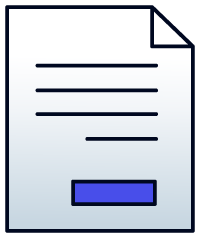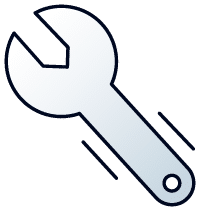Business Loan Calculators for Every Financing Product
Before you come to terms on a business loan, use a business loan calculator to determine which type of financing is right for you.
When you’re looking to secure a business loan, interest rates are just one piece of the larger puzzle. You also need to consider how much you intend to borrow, how long you’ll need to pay it back and most importantly, what level of return on investment you expect to earn with this loan.
By inputting the ideal elements of your commercial or small business loan, the calculator can help you identify the best loan options for your business based on your needs and qualifications.
Fast Capital 360’s Small Business Loan Calculators
The goal of Fast Capital 360’s small business loan calculators is to help you understand what your business can afford in the clearest terms possible. We’ll also break down some of the more involved components of a business loan. For example, we’ll simplify interest rates, APR, the different fees you might encounter and how you can reduce the overall cost of your loan.
Here’s what you’ll need to enter:
- Loan amount
- Loan term in years or months
- Yearly interest rate
When it comes to business loan calculators, we’ve got you covered. We have business loan payment calculators for each of the 7 most common financing types to help you compare options and learn what you can afford.
How Business Loan Payment Calculators Work
The business loan calculators work by taking the factors unique to the financing’s terms and outputting how much your payments will be and how much you will pay over the life of the loan.
Let’s review the factors the business loan calculator uses:
Trying to calculate APR or loan payments without using a small business loan calculator can be an adventure. While it’s certainly possible to figure out on your own, using a business loan payment calculator to determine repayment terms is more convenient and accurate.
How to Use Our Business Loan Payment Calculators
Use our business finance calculator online tool to calculate your monthly or weekly payments and the total cost over the life of your loan. Simply enter the following information:
- The loan amount found in your loan offer. Depending on the loan type you’re interested in, you can finance as little as $1,000 with accounts receivable financing or as much as $5,000,000 through an SBA loan.
- The estimated interest rate you were quoted. Depending on your creditworthiness, interest rates for a business term loan, for example, can be as low as 7%.
- The loan term and payment frequency. How you will be required to repay your debt will depend on the financing type and how much risk the lender is assuming. With an SBA loan, the lender provides longer payment terms since they are guaranteed payment from the government if the borrower defaults on the loan. Short term loans, on the other hand, will have to be repaid in a short amount of time (an 18-month maximum). Since short term loans have more abbreviated terms, your lender may require more frequent payments on a weekly, rather than a monthly, basis.
- Any fees quoted with your loan.
To see how much of an impact these factors have on repayment, use the business loan interest calculator and adjust the loan amount, term and frequency.
Understanding Your Business Loan Calculator Results
Using Fast Capital 360’s business loan payment calculators, you’ll have a much clearer sense of the true cost of financing. Whichever business loan repayment calculator you use, the outputs will be the same.
Payment
This is the fixed amount you’ll repay each week (or month) in principal, interest and fees.
Total Repayment Amount
Your total repayment amount estimates what you’ll pay over the life of the loan, including all principal, interest and fees.
Cost of the Loan
This sum represents what the lender is charging you to finance the loan in interest and fees. If you pay off the loan early, you may be able to reduce this number, but be cognizant of prepayment penalties.
With this information, it’s easy to evaluate different financing options, whether you’re comparing lenders or choosing between a short term loan or a merchant cash advance.
Oftentimes, borrowers are concerned with the weekly or monthly payment and whether or not they have enough cash on hand to cover the expense. While this is no doubt important, it’s only one piece of a larger puzzle. With Fast Capital 360’s business loan interest rate calculators, you can identify the loan option that’s best equipped to address your individual needs.
A Look at Small Business Lender Costs
Gaining a better understanding of how your business’s bottom line could be impacted by a small business loan is crucial. With the help of the business loan calculator, you’ll be able to plan effectively for how (and when) your business can best use a business loan.
In presenting the estimated costs of a business loan, there is no legally-mandated structure. However, there are common terms and phrases that financing companies use. To get more familiar with these terms, let’s further define them:
Interest Rates
An interest rate is arguably the most commonly used term to define the cost of borrowing money. Interest rates are expressed as a percentage of the amount a lender charges against the principal loan amount. Another way to look at it is that the interest rate is the cost to access the funds you need.
To further explain, let’s use an example.
In this scenario, Jennie’s Jellies secures a $50,000 business loan with 5-year terms and an interest rate of 9%. Since interest rates are usually computed on a yearly basis, the interest rate is reflected as 9% over the course of one 12-month period, equaling a consistent $1,038.00 monthly payment.
While Jennie’s Jellies monthly payment remains the same throughout the term, the repayment structure for an interest rate is broken into three main sections: interest, principal and balance. This process is known as amortization.
During the initial months, Jennie’s Jellies payments will be applied mostly against the loan’s interest. As the loan is paid down, the balance is reduced. As the balance is reduced, the amount the 9% interest rate is applied to is also reduced, ultimately resulting in a smaller interest payment. When all is said and done, Jennie’s Jellies will make 60 payments of $1,038.00, totaling $62,275.00 with $12,275.00 of interest paid.
We’ll dive into the types of fees that could be added to your loan later, but this is where a business loan interest rate calculator is so valuable.
Factor Rates
Another way to describe the cost of a loan is through a factor rate. While interest rates are expressed as a percentage, factor rates are presented as a decimal, usually ranging between 1.1 to 1.5. This cost presentation is most often used by alternative and short term lenders as well as merchant cash advance providers.
When using a factor rate, lenders multiply the principal loan by the decimal form to determine the total amount that will be repaid. To see how a factor rate would be expressed, let’s take a look at this simple example:
If Jennie’s Jellies secures a $50,000 merchant cash advance with a factor rate of 1.18, the total amount the company would repay would be $59,000. Let’s break this down even further.
Jennie’s Jellies is repaying $9,000 for immediate access to $50,000. If the financing were amortized, the interest rate would be 36%.
Since interest rates and factor rates are not interchangeable, though, this isn’t the right way to think about them. Factor rates do not amortize. This means all of the interest is charged to the principal when the loan or advance is created.
As a result, the total cost of the advance will not increase or decrease, regardless of whether you took 6, 12 or 18 months to pay back the loan.
One similarity factor rates do have with interest rates is that they may not account for other fees that the lender may charge.
Discount Rates
The third and final way lending companies are able to describe the costs of a business loan is through a discount rate or fee. Most commonly seen in invoice financing, lenders typically provide estimates as either weekly or monthly discount rates.
To give an example, let’s revisit our friends at Jennie’s Jellies.
In this scenario, let’s assume that Jennie’s Jellies has been factored against a $15,000 outstanding invoice that’s due in 4 weeks. The company providing the invoice financing to Jennie’s Jellies charges a discount fee of 1% per week, meaning they’ll have to pay $150 each week until their customer pays off the outstanding invoice. If Jennie’s Jellies customer does pay at the end of week 4, the company will have paid $600 as the cost for factoring the invoice.
Just as we saw with factor rates and interest rates, discount rates will most likely not account for other fees that the lender may charge.
The Role of APR in Business Loan Calculators
APR represents the interest rate plus any fees that are either associated or attached to a loan. Evaluating any loan or financing product with an APR gives you a more complete version of the overall cost to your business, making it much easier to compare and contrast all of your options.
Although both APR and interest rates are expressed as a percentage, be careful to not think APR and interest rates are interchangeable. For example, a lending company providing a loan will typically express its charges as an interest rate along with any additional fees, like the origination fee. The APR is the sum of all of these costs.
APR Example
Let’s break out what you need to know to fully understand APR. In this scenario, Jennie’s Jellies has been quoted with an interest rate of 11% from two competing lenders. Lender A includes fees of 2.5% while Lender B has an additional 4% in fees. While the interest rates are the same, the APR would be greater with Lender B. Fortunately, calculating APR doesn’t require a business loan interest calculator; it’s simple arithmetic ((interest rate + fees/ number of days in a term) X 365 ) X 100. While the fees can be a bit more challenging to calculate, the APR is simple to determine.
The Restrictions of APR
As with any cost expression, the practicality of APR only goes so far. Because of the way time impacts APR, it’s not always the most precise method of the total cost.
For example, the APR for a short term loan will naturally be higher than a long term loan. This happens because a long term loan spreads out the interest and fees over a period of years while a short term loan is more condensed. Still, this fact doesn’t make a short term loan more expensive than a long term loan. Given that a borrower has more time to repay the principal of the loan, there is also more time for the lender to generate more in interest charges.
For a short term loan specifically, the best approach is to consider how these funds will affect your bottom line. Will you be able to use these funds immediately? What is the opportunity cost of not securing this loan? What is your estimated return on investment? Ultimately, pursuing a loan should help your business drive growth.
As with any loan type, regardless of the final APR, you need to weigh whether or not your business can take on the payment. The last thing you want to happen is for the loan to become too much for the business. If you’re able to determine that these funds will help you achieve your goals, the higher, short term APR could be worth the greater upfront costs.
How Is Your Interest Rate and APR Determined?
Beyond the rates and fees that determine your total APR (which we’ll get into in the next section), there are a variety of other elements that determine your final APR, interest rate, factor rate or discount rate.
Let’s get more familiar with these factors:
Type of Loan
Depending on the type of loan you pursue or qualify for, the APR may naturally be higher or lower. For example, SBA loans are one of the most affordable loan options with a low APR thanks to its government guarantee.
Your Credit Score
For many lenders, a personal credit score of 650+ is indicative of someone who understands how to use their credit responsibly, meaning they’ll want to work with you. Simply put, the higher your credit score, the lower your rates and fees will be.
Health of Business
Much like your credit score, the longer you’ve been in business, the greater the likelihood that lenders will want to work with you. Typically, lenders want to see that applicants have at least 6 months in business, though companies with longer histories will receive more affordable offers.
Collateral
While not all loans require collateral, you’ll likely find that the more collateral you post, the less expensive the loan will be. Collateral offers security to the lender in the event you’re unable to fulfill the terms of the loan. As a result, the lender feels more comfortable with more borrower-friendly terms.
How Quickly You Need Funding
Depending on how quickly you need the funds, you may need to work with a company who specializes in helping small businesses secure financing within days. In these scenarios, the borrower may pay additional costs for the convenience of receiving the loan as soon as possible.
Loan Terms
Long term loans provide funding over an extended term. While short term loans do offer a smaller window for repayment, they aren’t as costly as a long term loan. Long term loans have more time to collect fees and interest from the borrower.
The Business Loan Fees You Need to Be Aware Of
As we described for each rate expression, only APR includes the cost of fees in its total estimation. It’s important to remember this when consulting with lenders to determine which loan type and company is right for you.
In this section, we’ll review 8 of the most common business loan fees and what it means for your loan.
Application Fee
When a potential borrower completes an application, the lending company performs both a credit and background check. Occasionally, lenders pass on the cost of these verifications.
Origination Fee
Origination fees serve as a way for lenders to recoup their administrative costs for servicing a loan. Typically, an origination fee is expressed as a percentage of the principal of the loan. For example, if you’ve come to terms on a loan for $50,000 with a 1% origination fee, you’ll be required to pay an upfront fee of $500.
Late Payment Fee
If for whatever reason you’re late making your regularly scheduled loan payment, lenders may charge an additional late payment fee. This fee can also come into play even if your lender uses automatic payments from your bank accounts. A late charge can be assessed if your account was found to have insufficient funds.
Check Processing Fee
In today’s electronic-everything world, it’s quite common for lenders to accept payment through Automated Clearing House (ACH) withdrawals. Some lenders do charge a fee to process these paper checks, however, so be sure to verify acceptable payment methods with any prospective lender.
Prepayment Fee/Penalty
While this is not a common practice with lenders, certain companies will charge an additional fee if you pay off your outstanding loan balance early. Essentially, this is to make sure that the lender is recouping all of the costs of preparing and providing the loan. The fee is typically determined as a percentage of the outstanding balance when paying off the remainder of the loan.
Guarantee Fee
There’s a chance you’ll need to pay a fee when applying for an SBA loan. Since the government guarantees part of every SBA loan, lender partners who issue the loans are required to pay a portion of the guarantee to the Small Business Administration. It’s not uncommon for the lender to pass this cost onto the borrower.
Draw Fee
A draw fee applies exclusively to business lines of credit. Essentially, lenders charge a fee ranging between 1% and 3% based on the amount you’ve drawn. Some lenders require borrowers to withdraw a certain amount of money at specific times, meaning that you can’t leave your account idle. While it’s a lesser-known fee, the total charges can add up.
Closing Costs
Compared to the other charges we’ve described, closing costs are not a fee necessarily. Closing costs are an aggregation of every possible cost and fee your loan is subject to. It’s imperative to keep your eyes open for every cost beyond your interest or factor rate. While the APR will be your final cost, understanding what lies beneath these calculations could save you hundreds, if not thousands, of dollars.
How You Can Reduce Your Loan Costs
One of the greatest advantages of using a business loan payment calculator is that you can estimate how much one type of loan could cost you. While having this upfront appraisal is remarkably useful, there are still ways for you to reduce your costs before or after you finalize a loan.
Let’s take a look at the three most common ways for reducing your costs:
Make Your Minimum Payments on Time
Just as it would be with any other bill, it’s important to make your minimum payments on schedule. Paying on time not only makes your life easier, but your credit score also stands to benefit. One of the easiest ways to stick to a schedule is to set calendar reminders in your smartphone’s calendar or, better yet, set up your account for automatic payments.
Ask Your Lender About Discounts and Prepayments
As we’ve learned, there are some lenders and financing companies that will charge a fee for any early prepayments. But not all lenders operate like this. The best way to determine how your lender works is to simply ask them about whether they offer (or are willing to offer) any prepayment options or discounts to reduce your total payback.
Use Valuable Collateral
Posting additional or more prized collateral can help to decrease the interest rate and, therefore, the overall cost of your loan. Cars, business equipment, homes and other real estate are commonly used collateral.
What Are the Most Cost-Effective Business Loans?
Arguably, some of the most cost-effective business loans include traditional term loans, SBA loans and business lines of credit. Each loan type carries its own unique rates and APR: Some are higher than others, while some feature shorter payment terms.
Traditional Term Loans
Similar to what you would find with a traditional bank, a business term loan provides flexibility and stability for any business in need of working capital. With a traditional term loan, businesses are able to secure up to $250,000 with terms up to 5 years on a set repayment schedule.
Interest rates typically start at 7% with APRs around 10% for the most qualified applicants. Depending on the type of lender you work with, it’s possible you could secure funding within 1 day of being approved. Use a working capital loan interest rate calculator to estimate what it would cost you to obtain traditional term loan financing.
SBA Loans
These are government-guaranteed long term loans from the Small Business Administration (SBA). The most popular SBA program is known as the SBA 7(a). Thanks to its connection to the government, SBA loans are not as risky to the lender who is actually providing the funds.
Terms can range between 5 and 25 years with loan amounts up to $5,000,000. SBA loans feature very attractive interest rates starting at 6.25%.
To calculate what an SBA loan might cost your business, click here.
Business Lines of Credit
With business lines of credit you’re able to borrow up to a maximum credit limit and only pay interest on the capital you borrowed.
Repayment terms range up to 2 years with loan amounts up to $250,000. While interest rates for business lines of credit start at 8%, this type of financing can be a bit more expensive than what you’d find through a traditional bank. The advantage of working with a lender over a bank is that the speed of funding can be as fast as 1 business day.
How to Evaluate the Top Financing Options for You
While cost is obviously an important element to consider, it’s not the only factor you need to consider.
Using a business loan calculator will help you finalize any initial cost estimates, but there are still a few more intangibles that should be recognized.
Reputation and Customer Service
Ideally, you should be reviewing two or more lenders before coming to terms with anyone. Even if their products, offers and costs are similar, reading their reviews will give you a much clearer idea of who they are as a company.
Collateral Requirement
While posting collateral is a simple way to lower your total payback costs, you risk losing your assets in the event of default. As you evaluate lenders, take note of who asks for collateral and who trusts you enough to not require that you post any.
Prepayment Penalties
Much like the collateral requirement, it’s much easier to work with a lender who doesn’t charge their clients for wanting to pay off their loans earlier than scheduled. If having the option to pay off your loan early is important to you, be sure to do your research and ask lenders to be clear about their early payoff policies.
The Final Tally on Business Loan Calculators
While financing fees can be tricky to lock down depending on the lender you work with, it’s much easier to determine your overall costs by using a business loan payment calculator.
Even though business loan repayment calculators do not assign a final estimation, they are excellent tools to assess your potential costs. As you begin to compare loans, you should start to notice how straightforward they actually are. And by using an online business finance calculator, you’ll have a much better idea of just how much your business can both secure and pay off.












